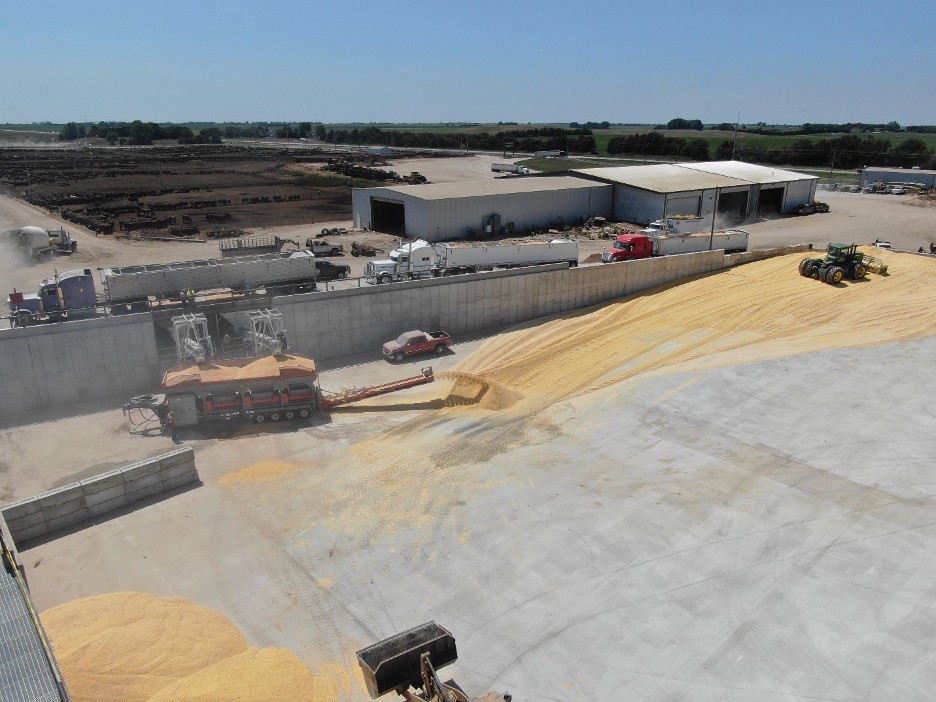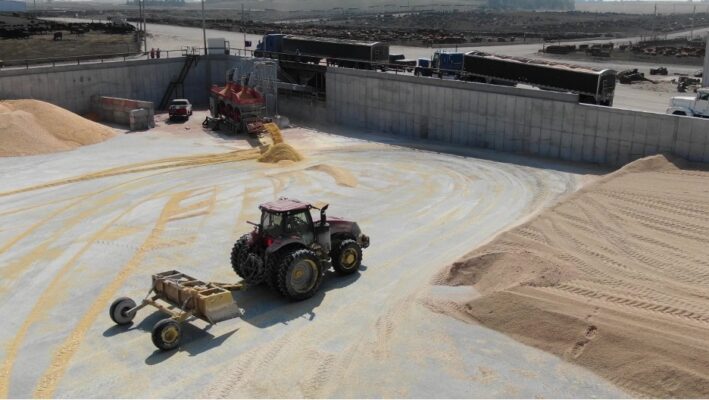
Deciding whether or not a high moisture corn area is a good fit for your operation doesn’t need to be a complicated one. We’ve broken down five key things you should consider when considering high moisture corn.
1. Location
When it comes to traffic flow and efficiency, the location of a high moisture corn facility in your operation is extremely important. HM corn processing and storage will take place in the high-traffic areas of your feedlot- near the existing feed mill, truck scales, and feed truck traffic. Ensuring that your HM corn storage is within 300 feet of your feed batching area will allow your feed loader/batcher to travel to/from the corn storage area for each batch of feed. Longer distances greatly decrease efficiencies and may require bulk transport of corn from the storage pile to a daily stockpile near the batching area.
When it comes to location, you also need to consider the layout of the corn offloading area. Trucks must be able to travel through existing facilities with ease and without delays- creating a seamless flow for the HM corn delivery trucks. Using your existing truck scale is possible, depending on the total daily truck traffic and orientation of your existing facilities to the new HM corn area. Along with these factors, a minimum of a 100-foot turning radius is recommended for semi traffic after offloading.
2. Volume
The pure volume of HM corn must be considered in sizing your grain handling facilities for this sector of the feeding operation. Equipment and personnel are not 100% efficient. For these reasons, additional productivity factors of 30% are recommended for equipment sizing. For example, if your goal is to offload and grind 10,000 bushels per hour, then your HM corn facilities should be sized for at least 13,000 bushels per hour. HM corn handling components include offloading into hoppers, drags and/or conveyors, and the hammer or roller mill itself.
HM corn season is a high volume/short time harvest period. To account for this, drive-over grates and pit hoppers are recommended and require design contingencies. Ultimately, the goal of these areas should be a constant flow of truck traffic, minimizing wait times and maximizing the effective use of your investment into the facility’s equipment.
3. Timing and Maximum Daily Intake
There is a short window of time for which HM corn can be harvested and transported. Typically, HM corn harvest lasts less than a month out of the year. This means that whether you are harvesting your own crop, or purchasing from local farmers, that truck turnaround time is extremely important. Keeping farmers happy with truck turnaround time ensures that you can purchase your corn cheaper and with fewer headaches.
Figuring your daily HM corn intake:
- Calculate the total daily ration needed. Multiply times 395 days (1 extra month) to determine your annual supply. We recommend one extra month of supply and storage capacity to feed during the following season’s harvest
- Divide the supply by number of working days in a HM corn harvest season to get the daily receiving capacity. A base number to use for this is 20 working days per HM harvest season
- Add 25-30% receiving capacity contingencies for processing equipment and personnel efficiencies
4. Storage
The storage of HM corn is similar to that of corn silage. Upon offloading then grinding, the corn is pushed into a mass storage pile and compacted with the weight of heavy machinery. Storage volume estimates are 1.25 ft3 /Bu., with a target of 45# DM/ft3. After the pile is complete, it is recommended to cover it with a plastic liner.
The sizing of an HM corn pad and its layout is entirely dependent on the total volume of corn required and your feedlot’s existing layout. As mentioned, you want the corn piled within a few hundred feet of the feed batching area. We recommend a concrete pad underneath the pile to reduce spoilage and ensure that corn can be ground, pushed, and piled without large weather delays during the critical harvest timeframe. HM corn can be piled as high as silage, although we do not recommend piling past 15-20 feet high unless space constraints require it.
5. Water and Inoculant
The moisture content of HM corn varies greatly throughout its harvest season. A proper setup must have the ability to add water to the ground corn at a high rate. This can be accomplished by the addition of piping and valving to the grinder. Even the late-season HM corn can be brought to a consistent moisture content before being stored. 35% moisture content is a base number to use for the end-goal moisture content of corn. Typically, corn is tested periodically upon arrival for moisture content.
Equally as important is the inoculation process of HM corn. We recommend using an inoculant spray system that applies directly to the ground corn as it exits the grinder, creating a consistent spray of inoculant that prevents spoilage of corn over time. These systems are simple to add towards the end of construction of your HM corn area but should be considered in the design and layout of the facility from the start.
Do you still have questions?
Our team has designed and built these systems for a variety of operations and would be glad to help you plan yours. With HM corn season being 6 months away, now is a critical time to begin the design and construction of these facilities for use in the 2021 harvest season.

